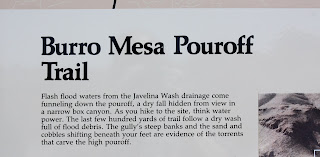MAY 19, 2013 BIG BEND
NATIONAL PARK - DAY 2
Today’s adventure once again finds us in Big Bend National
Park. Our route will begin shortly after
we get inside the Park gates and we turn onto Ross Maxwell Scenic Drive. This is the drive the Rangers recommend if
you only have one day in the park, the must see drive. I think we supported this theory by taking
174 pictures. There was some amazing
scenery, amazing varied scenery and scenery that just couldn’t be captured by
the camera.
The drive started by turning right at the Castolon/Santa
Elena Junction which would take us straight into the Chisos Mountains. Our first stop was shortly after we turned
onto the drive when we noticed a green clump of trees in the middle brown and
dry. What we were looking at was the
original homestead of Sam Nail who arrived in the park in 1916. One of the things he did in order to sustain
his was to build a well. I do not know
how long Sam stayed in the area but the both the well and the windmill are
still there and still working. The
windmill is still pumping water which keeps the fruit trees that he planted
alive and vibrant.
We left Sam’s place and continued on towards the Chisos
Mountains. They looked like paintings. Sometimes when you are reviewing pictures
they look like paintings and not photographs, no idea why. Here the actual
mountains looked like paintings, it was pretty amazing.
It was while we were driving through the mountains that I learned something new. I learned that there are dikes in the mountains. What are they????
The spines of rock of dark rock
marching across the desert floor are called dikes. Contemporaries of the Chisos Mountains, these
outcrops are evidence of the most recent igneous activity in the area. Like great stone fences, dikes can be traced
for miles across the park – reminders of the molten world beneath the quiet
desert surface.
I knew this because I took it right off an exhibit sign.
I took a few pictures that show
the dikes and how they travel across the mountains. Very interesting.
We slowly, and I mean slowly
continued through the mountains, taking pictures and enjoying the fabulous
scenery. In one picture you can the
remains of the Homer Wilson Ranch which was one of the original homesteads in
this area. The National Park Service
bought it 1942 and incorporated it into Big Bend Park. The ranch was abandoned in 1945, a year after
Homer Wilson died.
A short jaunt up the road we came
to Sotol Vista which gave us an overview of the remainder of the park to the
south. The cliffs in the distance of the
first picture belong to Mexico. We could
see Trap Mountain, Goat Mountain, Santa Elena Canyon (which was our final
destination) and Kit Mountain. Also
visible was Tule Mountain, Burro Mesa, Little Christmas Mountain and Christmas
Mountain. I wish I had a lens that could
have captured what we saw, it was a spectacular view.
We left the vista and dropped
down onto the valley floor and made short stops at Burro Mesa Pouroff, Mule
Ears View Point and Tuff Canyon. Burro
Mesa Pouroff and Tuff Canyon would be an amazing place to visit during the
monsoon season. I just wouldn’t want to
be too close. Mule Ears Peaks are one of
the more famous and widely photographed landmarks.
 |
| Burro Mesa Pouroff |
 |
| Mule Ears Peaks |
 |
| Tuff Canyon |
We stopped at a Visitors Centre
where we had our first real look at the Rio Grande Valley. I was amazed to learn that at one time cotton
was grown in the valley. A gentleman by
the name of Wayne Cartledge raised cotton from 1922 to 1942 when production
costs forced him to forgo the venture.
One unique area was Cerro
Castellan or Castolon Peak.
 |
| Cerro Castellan |
The layers visible in Cerro
Castellan reveal millions of years of volcanic events. Stacked in this tower are several lava flows
and volcanic tuffs (ash deposits), with layers of gravel and clay from periods
of erosion between eruptions. We also
took pictures of further signs of volcanism, pale beds of volcanic ash and dark
basaltic boulders.
As we continued we finally got
our first look at the Rio Grande. This
time of the year it does not look so large but you can see how the banks expand during the monsoon season.
The next and last stop will be
Santa Elena Canyon where we planned to hike into the canyon. This is rated as one of the premium short
hikes in the park.
 |
| Santa Elena Canyon |
We arrived at the trail head,
loaded up with water, grabbed the camera and headed out. The hike was only 1.8 miles but there was a
lot of climbing. The heat and altitude
really got to us and this hike took us pretty much to our limits. Thankfully we took lots of water. The trip took us into the narrowest part of the
canyon which separates Mexico and Texas.
It was pretty spectacular and of course we took a few pictures.
When we got back to the car it
was 106 degrees and we wondered why were exhausted. We decided at that point to take Old Maverick
Road back to the main road. This cut
about 25 miles off of our return trip.
It was a gravel road and unusable during certain times of the year but
this was not one of them. Of course we
stopped for a couple of pictures.
We reached the main road and
headed home. We were exhausted but very
pleased with our day, another great retirement day.








.jpg)
































No comments:
Post a Comment